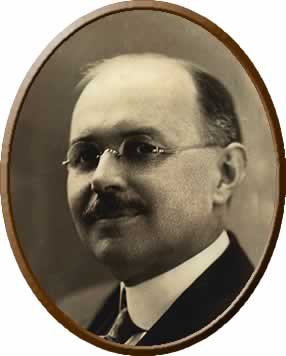Gabriel Hiester was a prominent fruit grower in the vicinity of Harrisburg. At a delegate meeting at the College in 1879, he was elected to the Board of Trustees. He was appointed to the Executive Committee of the Board in 1908 and served on the Agriculture Advisory Committee from 1908 until his death in 1912. During Heister's period of service the delegates from the county agricultural and engineering organizations were largely from the County Horticultural Societies and Heister was regarded as representing the horticultural interests on the Board although he was too broad a man to confine his efforts to any one branch of agriculture.
Gabriel Hiester's death in 1912 was a serious loss to the Board of Trustees and presented a serious problem to the delegates to appoint a replacement of his caliber. At the meeting in 1912 Chester J. Tyson was selected.
The Tyson's, an old Quaker family, had moved from the Philadelphia area into Adams County at Flora Dale near Biglerville and established a fruit nursery and commercial planting of apples. Chester grew up in these surroundings and later with his two brothers he expanded the orchard plantings and organized an orchard supply company which became well known throughout the Cumberland-Shenandoah orchard area.
Chester Tyson came to the Board of Trustees at a critical time. Penn State was just beginning to recognize its future role as a Land Grant College and to realize the importance of the School of Agriculture in that development. In 1912 the School of Agriculture had an enrollment of 514 regular four year students and a faculty of 60. The recent development of the Agricultural Extension Division and the establishment of the County Agricultural Extension Agent service was bringing the school in much closer contact with the farmers of the state. The general increase in college enrollment following the close of the first World War was necessitating a very rapid development of the School of Agriculture along with a large increase in the entire College. To aid in securing new staff members to get increased appropriations for new buildings and to expand the college area, especially College farms, to keep up with this growth required dedicated service from the Trustees both at State College and at Harrisburg. In those days there was no Nittany Lion Inn and only a horse-drawn carryall for transportation. A meeting of the Board of Trustees could mean three to four days away from home and uncertain accommodations at State College.
Chester Tyson took all of these responsibilities very seriously. The rapid expansion of campus buildings was over running the areas formerly used by the Horticulture Department. When new Beaver Field took the land where the second College orchard was planted, one of the last acts of Gabriel Hiester was to secure the area now called the Hiester Farm for the future use of the Horticulture Department. Tyson followed of these orchards very closely and during nearly every Board meeting took time to go over plans and visit the area. Frequently he persuaded Dean Watts to go with him. The close friendship between Watts and Tyson many times worked to the advantage of the School of Agriculture during Board meetings.
Chester Tyson and Ed Bayard believed it was their responsibility to know personally the staff of the School of Agriculture. Bayard kept close watch of Agronomy and the animal industries; Tyson's special interest was Horticulture. hardly a Board meeting went by without these men spending some time with the staff members in their particular fields. Also they were always interested in the problem of selecting new members. Although it was not in his particular fields, Ed Bayard was responsible for bringing Frank Fagan to Penn State. These visits did not stop with the department head. The staff was small in those days and Bayard and Tyson together knew practically all in the School of Agriculture. No new farms were purchased without the careful study of these two. They knew the research program and followed its development closely. Their shrewd but kindly criticism and suggestions encouraged many a young staff member through very trying times.
Practically all of the research program of the Horticulture Department had its beginning during Tyson's period of service. He served on the Executive Committee of the Board of Trustees from 1924 until his death in 1938. In this position he was able to secure budgetary recognition of the needs of the Department at a time when money was very difficult to secure. His standing among commercial growers in the state was a great help in establishing contacts for field studies. The limited facilities and restricted finances at State College made it necessary to conduct many field tests with the fruit and vegetable growers of the state. Tyson's help in securing funds in the Department budget was invaluable. Any of the Tyson orchards was always available for such tests.
Very few people, even staff members, realize the financial contribution trustees made in long service on the Board. Ed Bayard once said it had cost him $10,000 during his period of service and this did not include loss of time spent on College business. Tyson's expenses were probably very close to Bayard's. To carry on the half dozen experiments in his own orchards was no small addition to this expense.
Institutions are notoriously forgetful of their benefactors. In a College generation the service generation the services of its pioneers are all but forgotten. The least that can be done is to dedicate a suitable building to each of those whose services have meant the most to the growth of the institution.
Department of Plant Science
Address
102 Tyson BuildingUniversity Park, PA 16802
Department of Plant Science
Address
102 Tyson BuildingUniversity Park, PA 16802


